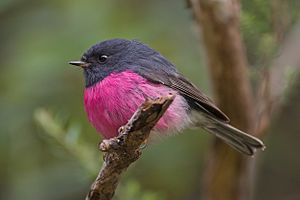Rose breast snapper
| Rose breast snapper | ||||||||||||
|---|---|---|---|---|---|---|---|---|---|---|---|---|

Rose breast flycatcher ( Petroica rodinogaster ), male |
||||||||||||
| Systematics | ||||||||||||
|
||||||||||||
| Scientific name | ||||||||||||
| Petroica rodinogaster | ||||||||||||
| ( Drapiez , 1819) |
The rose -breasted flycatcher ( Petroica rodinogaster ), sometimes also called the rose -colored flycatcher , is a songbird from the family of flycatchers (Petroicidae) that occurs in Australia and Tasmania .
features
Rose breast snapper reach a body length of 11.5 to 13.0 centimeters and a weight of 9.0 to 11.0 grams. There is a clear sexual dimorphism between the sexes in terms of plumage color . Only in the males are the head, throat and back as well as the wings and control feathers black. The chest and stomach are magenta in color. Small whitish areas stand out on the forehead and rump. The females show an olive-brown basic color, with the breast and stomach area contrasting with ocher. The beak is blackish in both sexes, the iris black, legs and feet are gray-brown.
Distribution, subspecies and habitat
The rose breast flycatcher occurs only in Australia and Tasmania . In addition to the nominate form Petroica rodinogaster rodinogaster , which occurs on Tasmania and the islands in the Bass Strait , another subspecies is known:
- Petroica rodinogaster inexpectata Mathews , 1912, on the southeastern tip of Australia.
The main habitat of the species are rainforest areas and moist eucalyptus forests. Outside the breeding season, it can also be found in dry, open areas.
Way of life
The birds feed on insects and other arthropods, which they look for on the ground or in low vegetation and which they sometimes catch from the air. The breeding season falls from September to March. Sometimes there are two broods. The bowl-shaped nest has an outer diameter of around seven centimeters and is usually placed in a fork of branches at a height of two meters above the ground. It is made from dry grass, moss and animal hair and intertwined with spider threads. The female is solely responsible for building the nest. After completion, two to four eggs are laid, which the female then hatches in 16 days. Both parents provide the young with food. As brood parasites sometimes occur the fantail Cuckoo ( Cacomantis flabelliformis ) or Horsfield's bronze cuckoo ( Chrysococcyx basalis ) on.
Danger
In Tasmania, the rose breast flycatcher is widespread, sometimes numerous, and is therefore classified as ![]() “ least concern” by the World Conservation Organization IUCN . Due to deforestation in rainforest areas, however, it is listed in New South Wales as " vulnerable = endangered".
“ least concern” by the World Conservation Organization IUCN . Due to deforestation in rainforest areas, however, it is listed in New South Wales as " vulnerable = endangered".
Individual evidence
- ↑ a b c d e W. Boles (2017). Pink Robin (Petroica rodinogaster). In: J. del Hoyo, A. Elliott, J. Sargatal, DA Christie & E. de Juana (eds.): Handbook of the Birds of the World Alive. Lynx Edicions, Barcelona. (viewed at http://www.hbw.com/node/59310 on May 6, 2017).
- ↑ dissemination
- ^ IOC World Bird List
- ^ IUCN Red List
literature
- Josep del Hoyo , Andrew Elliott, Jordi Sargatal: Handbook of the Birds of the World, Picathartes to Tits and Chickadees. Volume 12, Lynx Edicions, 2007, ISBN 978-84-96553-42-2 .
Web links
- Rose breast flycatcher (Petroica rodinogaster) in the Encyclopedia of Life . Retrieved August 11, 2017.
